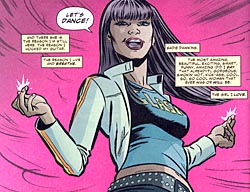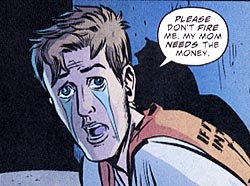 By David Lapham
By David Lapham
32 pages, color
Published by Vertigo/DC Comics
I still remember when David Lapham’s Stray Bullets #1 first hit stores. It was a huge leap forward for him artistically, and the writing was like nothing I’d have expected from Lapham. At the time he was best known for his work on books like Harbinger and Warriors of Plasm; his gritty, urban crime story was a far cry from psychic teenagers or inter-dimensional gladiators. With the debut of his new series Young Liars for Vertigo, I was ready to be blown away with a new Lapham creation. What I found, though? Certainly not what I was expecting.
A group of friends in Manhattan are a disparate bunch—the uninhibited and reckless daughter of a billionaire, her rocker-wanna-be boyfriend from Texas, a jaded drag queen, a bitter anorexic has-been model, a rock band groupie, and a spoiled daddy’s boy. They’re hanging out together, even though one of them may have betrayed another three months ago. Now they’re all about to go on a journey with no definite ending in sight, but one that certainly won’t end well.
 If I’d read the first two issues of Young Liars without knowing who’d worked on the book, one of my first instincts would have been that the creator really wanted to be Lapham. That’s not really a compliment, though, doubly so once you realize that it is Lapham writing and drawing Young Liars. One of the things I’d liked about Stray Bullets was that it started small and grew over time, almost like a series of concentric circles where each new ring was bigger than the previous one, but contained everything that had happened up until that point in time. Young Liars goes the other route, dumping you right into the middle of everything and throwing everything short of the kitchen sink at the reader. The problem is, I don’t think this approach really works here. His main characters come across as less than sympathetic right from the start, and even more crucially it’s hard to want to learn about them. Early on you discover that Sadie has a bullet lodged in her brain that will eventually kill her, and it’s that bullet which has caused her moral and emotional centers to be damaged. The thing is, though, by this point she’s already come across as crass and obnoxious and a bit of an annoyance. She’s so over the top that it’s hard to see her as anything but a caricature, and I genuinely found myself cringing when she showed up. That’s a problem that just about all of the characters in the first issue have; even the ones that Donnie’s narration says you should like have a singular lack of a hook to make you interested in their travails. When Truman shows up and starts whining about how his daddy won’t help him from getting evicted from the co-op, it doesn’t matter that Donnie says Truman is liked by everyone. Instead he just comes across as immature and grating, and he’s hardly the only member of the cast to be this way.
If I’d read the first two issues of Young Liars without knowing who’d worked on the book, one of my first instincts would have been that the creator really wanted to be Lapham. That’s not really a compliment, though, doubly so once you realize that it is Lapham writing and drawing Young Liars. One of the things I’d liked about Stray Bullets was that it started small and grew over time, almost like a series of concentric circles where each new ring was bigger than the previous one, but contained everything that had happened up until that point in time. Young Liars goes the other route, dumping you right into the middle of everything and throwing everything short of the kitchen sink at the reader. The problem is, I don’t think this approach really works here. His main characters come across as less than sympathetic right from the start, and even more crucially it’s hard to want to learn about them. Early on you discover that Sadie has a bullet lodged in her brain that will eventually kill her, and it’s that bullet which has caused her moral and emotional centers to be damaged. The thing is, though, by this point she’s already come across as crass and obnoxious and a bit of an annoyance. She’s so over the top that it’s hard to see her as anything but a caricature, and I genuinely found myself cringing when she showed up. That’s a problem that just about all of the characters in the first issue have; even the ones that Donnie’s narration says you should like have a singular lack of a hook to make you interested in their travails. When Truman shows up and starts whining about how his daddy won’t help him from getting evicted from the co-op, it doesn’t matter that Donnie says Truman is liked by everyone. Instead he just comes across as immature and grating, and he’s hardly the only member of the cast to be this way.
Things in some ways actually get worse instead of better in the second issue. Flashing back three years earlier in Donnie’s life, before he came to Manhattan, I can only imagine that the idea here is to gain some sort of sympathy for everything Donnie’s gone through. Instead, though, it actually made me hate him a little more. Between his constant suicide fantasies, his lack of caring that his friend just sexually assaulted another member of their band (aside from needing a new bass player), or his perpetual crying that he loves Sadie and is feeling betrayed (even though he’s never even spoken to her and only seen her once from afar), he’s an amazingly unlikable character. You don’t want him to do well, you actually start wanting to see him fail. By the time you get to what I can only imagine is supposed to be a shocking finale to the story, it’s just a relief that the issue is finally over.
 The art, at least, isn’t bad when it comes to Young Liars. There are things here that Lapham does well, like Sadie’s mean-eyed look, or her sudden shift over to hedonism. I like how he draws the characters in general, even if some of them look a little familiar (Donnie and Truman, for instance), and he’s not afraid to use a lot of panels on a page to get his story told; eight-page grids are drawn almost matter-of-factly, letting Lapham focus tightly on a single character or moment and get a lot of information across on a single page. The one thing I’m less than crazy about is Lee Loughridge’s coloring in the first issue; it’s garish and actually a little hard to look at with all of its greens and purples. Things are thankfully much more toned down in the second issue, still showing a lot of variety but without looking like a stylistic nightmare.
The art, at least, isn’t bad when it comes to Young Liars. There are things here that Lapham does well, like Sadie’s mean-eyed look, or her sudden shift over to hedonism. I like how he draws the characters in general, even if some of them look a little familiar (Donnie and Truman, for instance), and he’s not afraid to use a lot of panels on a page to get his story told; eight-page grids are drawn almost matter-of-factly, letting Lapham focus tightly on a single character or moment and get a lot of information across on a single page. The one thing I’m less than crazy about is Lee Loughridge’s coloring in the first issue; it’s garish and actually a little hard to look at with all of its greens and purples. Things are thankfully much more toned down in the second issue, still showing a lot of variety but without looking like a stylistic nightmare.
The one thing that grabbed my attention with Young Liars is the lack of continuity between the two issues. If you read them back to back, there’s a real lack of a reliable narrator between them. Events in the two don’t sync up; comments that Donnie makes about his family in the first issue don’t match the second one, and Sadie’s behavior three years before the near-fatal shooting incident seem remarkably similar to those afterwards. It makes me wonder just how apt the title Young Liars really is, because something really doesn’t add up here. At the same time, though, it’s not really enough to make me want to stick around and find out. It’s a bit of a quandary in the end, because I have three beautiful Stray Bullets oversized hardcovers on my bookshelf, and I would absolutely love for the long promised fourth one to show up, as well a fifth and (once one more issues of the series was released) sixth hardcover. And I can’t help but think that if Young Liars does well, it will perhaps help fund Lapham’s publishing of the rest of Stray Bullets. But you know what? I just can’t get behind Young Liars. I wish I could. But this feels like a tremendous letdown, on a number of levels.
